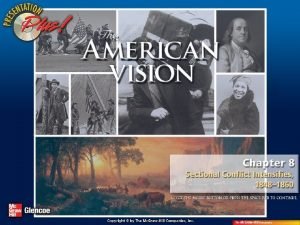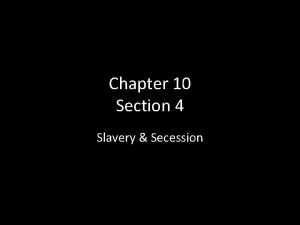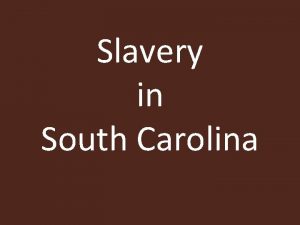Slavery Starters Starter 1 Slavery World History 1





- Slides: 5

Slavery Starters

Starter # 1 -Slavery & World History • 1. ____ Slavery is a product of capitalism. • • 1. 2. ____ Myth: Slavery was an economically backward and inefficient institution. • 2. 3. ____ Slaves were always subject to torture, sexual exploitation, and arbitrary death. • 3. • 4. ____ Slavery was always based on race. • 4. • 5. ____ Slavery is older than the first human records. • 5. • 6. ____ Slavery is virtually a universal institution. • 6. • 7. • 8. • 9. • 10. • • 7. ____ Not until the 15 th century was slavery associated primarily with people of African descent. • 8. ____ Slavery is a product of Western Civilization. • 9. ____ Slavery in the non western world was a mild, benign, and non economic institution. • 10. _______ Many of the most progressive societies in the world had slaves Myth Fact Fact Myth Fact

Starter # 2 Enslavement and the Slave Trade • 1. ____ New World slaves came exclusively from West Africa. • 2. ____ There is no evidence that slaves were captured with nets; war was the most important source of enslavement. 3. ____ War was the most important source of enslavement; it would be incorrect to reduce all of these wars to slave raids. 4. ____ The Middle Passage stripped enslaved Africans of their cultural heritage and transformed them into docile, passive figures wholly receptive to the cultural inputs of their masters. • • • 1. • 2. • 3. • 4. • 5. • 6. • 7. • 8. ____ Europeans physically enslaved Africans or hired mercenaries who captured people for export or that African rulers were "Holocaust abettors" who were themselves to blame for the slave trade. • 9. • 10. 9. ____ Many slaves were captured with nets. • 11. • 12. 5. ____ Europeans did engage in some slave raiding; the majority of people who were transported to the Americas were enslaved by Africans in Africa. 6. ____ Kidnapping was the usual means of enslavement. 7. ____ Slaves engaged in at least 250 shipboard rebellions. 10. ____ Kidnapping was the usual means of enslavement. 11. ____ Half of all New World slaves came from central Africa. Myth Fact Myth Fact

Starter # 3 -Slavery in the Americas • • 1. ____ Most slaves were imported into what is now the United States 2. ____ African slaves were the only remedy for the labor shortages that plagued Europe's New World dominions. • 1. • 2. • 3. • 4. 5. ____ Slave labor made it profitable to mine for precious metal and to harvest sugar, indigo, and tobacco; slaves taught whites how to raise such crops as rice and indigo. • 5. • 6. ____ Well over 90 percent of slaves from Africa were imported into the Caribbean and South America • 6. • 7. ____ Slaves arrived in Spanish Florida at least a century before 1619 and a recently uncovered census shows that blacks were present in Virginia before 1619. • 7. • 8. • 9. • • • 3. ____ The first slaves arrived in what is now the U. S. in 1619 4. ____ Europeans arrived in the New World in far larger numbers than did Africans. 8. ____ Slavery played a marginal role in the history of the Americas 9. ____ Before 1820, the number of Africans outstripped the combined total of European immigrants by a ratio of 3, 4, or 5 to 1. Myth Fact Fact Myth Fact

Starter # 4 - Slave Culture • 1. ____ The slave trade permanently broke slaves' bonds with Africa. • 2. ____ African nations persisted in America well into the 18 th century and even the early 19 th century. • • 3. ____ Slaveholders sought to deculturate slaves by forbidding African names and languages and obliterating African culture. 4. ____ Slaves adapted religious rites and perpetuated a rich tradition of folklore. 5. ____ In fact, slaves were rarely named for owners. Naming patterns appear to have reflected African practices, such as the custom of giving children "day names" (after the day they were born) and "name saking, " such as naming children after grandparents. 6. ____ Masters assigned names to slaves or slaves imitated masters' systems of naming. 7. ____ Slaves were able to draw upon their African cultural background and experiences and use them as a basis for life in the New World. 8. ____ While de culturation was part of the "project" of slavery, in fact African music, dance, decoration, design, cuisine, and religion exerted a profound, ongoing influence on American culture. 9. ____ Plantation life with its harsh labor, unstable families, and high mortality, made it difficult for Africans to construct social ties • 1. • 2. • 3. • 4. • 5. • 6. • 7. • 8. • 9. Myth Fact Myth Fact Myth









